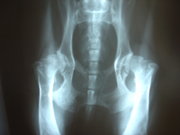

Custom Search
|
Hip dysplasia is a congenital disease that, in its more severe form, can eventually cause lameness and painful arthritis of the joints. It is caused by a combination of genetic and environmental factors. It can be found in many animals and occasionally in humans, but is common in many dog breeds, particularly the larger breeds.
 Hip dysplasia with osteoarthritis
Hip dysplasia with osteoarthritis
In the normal anatomy of the hip joint, the thigh bone (femur) joins the hip in the hip joint, specifically the caput ossis femoris. The almost spherical end of the femur articulates with the hip bone acetabulum, a partly cartilaginous mold into which the caput neatly fits. It is important that the weight of the body is carried on the bony part of the acetabulum, not on the cartilage part, because otherwise the caput can glide out of the acetabulum, which is very painful. Such a condition also may lead to maladaptation of the respective bones and poor articulation of the joint.
In dogs, the problem almost always appears by the time the dog is 18 months old. The defect can be anywhere from mild to severely crippling. It can cause severe osteoarthritis eventually.
In dogs, there is considerable evidence that genetics plays a large role in the development of this defect. There might be several contributing genetic factors, including a femur that does not fit correctly into the pelvic socket, or poorly developed muscles in the pelvic area. Large and giant breeds are susceptible to hip dysplasia. Cats are also known to have this condition, especially Siamese.
The classic diagnostic technique is with appropriate X-Rays and hip scoring tests. These should be done at an appropriate age, and perhaps repeated at adulthood - if done too young they will not show anything. Since the condition is to a large degree inherited, the hip scores of parents should be professionally checked before buying a pup, and the hip scores of dogs should be checked before relying upon them for breeding.
Overfeeding puppies and young dogs, particularly in the giant breeds, might aggravate the problem or bring it on earlier, because pups tend to be more active, less aware of their physical limitations, and have immature bones and supporting structures carrying their weight. Dogs from breeds which are known to be prone to dysplasia, can be kept slightly leaner than normal until around 2 years old, by which time the bones are full strength and the animal can be easily brought up to its normal adult weight. Overexercising young dogs whose bones and muscles have not yet fully developed might also be a contributing factor.
Dogs might exhibit signs of stiffness after rising from rest, reluctance to exercise, bunny-hopping gait, lameness, pain, or wasting away of the muscle mass in the hip area. Radiographs often confirm the presence of hip dysplasia, but radiographic features may not be present until two years of age in some dogs. Moreover, many affected dogs do not show clinical signs, but some dogs manifest the problem before seven months of age, while others do not show it until well into adulthood.
There is no complete cure, although surgery can alleviate the clinical signs. Depending on the extent of the problem, surgical alternatives include excision arthroplasty, in which the head of the femur is removed and reshaped or replaced; pelvic rotation--triple pelvic osteotomy or pubic symphodesis--in which the hip socket is realigned, may be appropriate if done early enough. Hip replacement is also possible, it is expensive but (since it completely replaces the faulty joint) has the highest percentage of success, usually restores complete mobility, and also completely prevents recurrence.
Since less joint mobility may result in loss of muscle mass and quality as a dog ages, there is often an advantage in having hip replacement whilst the dog is at an early age, while muscle is more likely to re-developed, rather than in old age when convalsecence is longer and more difficult.
Responsible breeders who track the incidence of hip dysplasia have been able to reduce the incidence in some breeds but not to eliminate it altogether.
Cats, made by MultiMedia | Free content and software
This guide is licensed under the GNU Free Documentation License. It uses material from the Wikipedia.